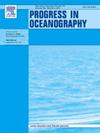从1977年到2017年,在缅因湾,变暖超过了分层,导致了具有不同生活史的桡足类动物(Calanus finmarchicus和Centropages typicus)的丰度
IF 3.6
3区 地球科学
Q1 OCEANOGRAPHY
引用次数: 0
摘要
桡足类动物是海洋食物网中重要的能量通道,将自下而上的生物地球化学循环和生产力动态转移到上层营养水平。缅因湾是研究桡足动物种群动态、海洋条件和气候之间关系的模型系统。过去的研究已经确定了桡足类物种丰度和群落组成的大时间振荡,与生物大小一致,并与北大西洋涛动的振荡有关。然而,解释气候指数与浮游生物群落之间的相关性可能是复杂的,因为气候指数是多种大尺度海洋现象的综合。我们的研究测试了关于缅因湾桡足动物丰度的年代际趋势和环境驱动因素的假设,重点关注两个具有不同生活史和体型的物种。利用广义加性模型和马尔可夫切换模型的组合,我们确定了过去40年里,黄颡鱼(Calanus finmarchicus)和典型黄颡鱼(Centropages typicus)丰度的四个关键过渡时期,分别为1986年、1997年和2000年(C. finmarchicus/C. 2000)。Typicus)和2006年。从1977年到20世纪90年代末,两个物种的混合层深度与桡足类丰度的关系最为持久,我们假设水文-营养-浮游植物动力学是桡足类丰度年际变化的主要驱动因素。2006年以后,与温度相关的变量,包括缅因湾的表面温度和底水的暖坡水部分,成为丰度的主要环境相关因素,特别是对C. finmarchicus而言。这一转变表明,缅因湾桡足动物群落年际模式与以往几十年的环境驱动因素有所不同。这种变化在历史记录(1977-2017)中是前所未有的,基于先前时间框架(1977-2006)的模型将无法预测这一事件。这些数据强调了快速变暖对长期建立的浮游生物群落动态的破坏性,并强调在缅因湾以及其他预计会快速变暖的地区开发管理工具和策略时,需要考虑这些非平稳关系。本文章由计算机程序翻译,如有差异,请以英文原文为准。
Warming overtakes stratification in driving abundance of copepods with contrasting life histories (Calanus finmarchicus and Centropages typicus) in the Gulf of Maine from 1977 to 2017
Copepods are key conduits of energy in ocean food webs, transferring bottom-up biogeochemical cycling and productivity dynamics to upper trophic levels. The Gulf of Maine is a model system for studying relationships among copepod population dynamics, oceanographic conditions, and climate. Past studies have identified large temporal oscillations in copepod species abundance and community composition, aligned with organism size and associated with oscillations in the North Atlantic Oscillation. However, interpreting correlations between climate indices and plankton communities can be complex, as climate indices are the synthesis of multiple large-scale oceanographic phenomena. Our study tested hypotheses about interdecadal trends in, and environmental drivers of, Gulf of Maine copepod abundance, focusing on two species with different life histories and body size. Using a combination of Generalized Additive Models and Markov Switching Models, we identified four key transition periods in both Calanus finmarchicus and Centropages typicus abundance over the past 40 yrs, defined by the years 1986, 1997/2000 (C. finmarchicus/C. typicus), and 2006. The mixed layer depth had the most persistent relationship with copepod abundance from 1977 to the late 1990s in both species, and we hypothesize that hydrographic-nutrient-phytoplankton dynamics were the primary drivers of the changes in interannual copepod abundance. Temperature-related variables, including Gulf of Maine surface temperature and the Warm Slope Water fraction of bottom water, became the primary environmental correlates with abundance after 2006, particularly for C. finmarchicus. This shift indicated a departure from previous multi-decadal environmental drivers of interannual copepod community patterns in the Gulf of Maine. This change was unprecedented in the historical record (1977–2017), and models based on prior time frames (1977–2006) would have been unable to forecast this event. These data highlight the disruptive nature of rapid warming on long-established plankton community dynamics and emphasize the need to account for these nonstationary relationships when developing management tools and strategies in the Gulf of Maine, as well as other regions where rapid warming is expected.
求助全文
通过发布文献求助,成功后即可免费获取论文全文。
去求助
来源期刊

Progress in Oceanography
地学-海洋学
CiteScore
7.20
自引率
4.90%
发文量
138
审稿时长
3 months
期刊介绍:
Progress in Oceanography publishes the longer, more comprehensive papers that most oceanographers feel are necessary, on occasion, to do justice to their work. Contributions are generally either a review of an aspect of oceanography or a treatise on an expanding oceanographic subject. The articles cover the entire spectrum of disciplines within the science of oceanography. Occasionally volumes are devoted to collections of papers and conference proceedings of exceptional interest. Essential reading for all oceanographers.
 求助内容:
求助内容: 应助结果提醒方式:
应助结果提醒方式:


